The year 2003 celebrated the centennial birthday of the National Wildlife Refuge System, a network of public lands purchased, enhanced, restored and maintained by the US Fish & Wildlife Service for wildlife and their habitats, and preserved for the enjoyment of present and future generations. It's a gift to the people, by the people and a gift to the wild creatures who share the planet. Here is a peek into the lives of all five refuges in the state of New Jersey. They deserve a round of applause.
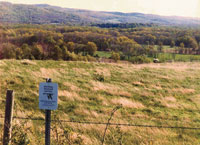
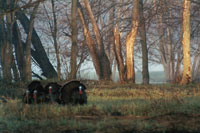
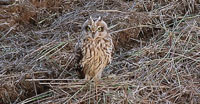
Upland forest and shrubland, grassland, swamp, marsh and fen, floodplain of the north-flowing Wallkill River that runs through the black dirt of Sussex County, NJ and Orange County, NY form the refuge that stretches through the Vernon Valley between the Kittatinny Ridge and the Highlands. The river beckons the adventurer.
There are three trails in the valley, where visitors can get great impressions of just what refuges are about the enhancement and protection of wildlife and habitats. The Wood Duck Trail is excellent in fall and spring, taking the walker through forested wetland where herons and wood ducks live. The Dagmar Dale Trail zips through upland fields and forests with vistas across the valley to the mountains. A diversity of habitat types includes grassland, limestone outcrops, wetlands, and woods, and the lucky walker can see fox, mink, otter, coyote, black bear and bobcat.
One reason the refuge was founded along the Wallkill River is that floodplain provides excellent habitat for migrant ducks. Its seasonal flooding causes a rich abundance of invertebrates, and plants, such as tickseed sunflowers, smartweeds, sedges and rushes, that produce a lot of seed that sets a great table for resting and feeding migrant waterfowl. Grasslands cover 1,800 acres. "There are a lot of rare and declining birds such as bobolink and Eastern meadowlark that need grassland areas for habitat," says Kohl. "We are particularly concerned about grassland birds because, as a group throughout the continent over 30-40 years, they've shown the steepest decline of any birds in North America."
At Wallkill, the structure of plant communities ranks high. Cool-season grasses tend to be pasture and hay. Warm-season grasses actively grow in summer. When the cool go dormant, the warm grow lush with tall, dense grass good cover for turkey and mallards. Cool-season tend to be short and sparse better for bobolink, meadow lark and savanna sparrow, grasshopper sparrow. Trunks of trees provide shade underwater, sunning spots for frogs and perches for herons.
The Liberty Loop Trail is shaped like a rectangle around a series of freshwater impoundments separated by drainage ditches, home to a high concentration of ducks and geese in the fall and birds of prey in the winter. There's much to see and savor on these 4,577 acres. "A critical part about being a long-term refuge providing habitat for wildlife is also being valued by the community," says Steve Kahl, acting refuge manager.
The Liberty Marsh Restoration Project is a cooperative effort with Ducks Unlimited to restore 350 acres of wetlands, providing feeding and breeding habitat for migrant waterfowl (ducks and geese) and nongame species including migrant shorebirds (e.g. sandpipers, herons and egrets), wintering raptors, and breeding amphibians, says Steve Kahl, acting refuge manager. "The sounds of frogs and toads can be deafening," says Kahl. "The gray tree frog really likes that area."
Before the land became refuge, it was a sod farm with ditches and dikes to drain it. A large dike was built to separate the land from the Wallkill River. When the river overran its banks, the farmers pumped the fields dry. In today's effort to return the land to its natural wetland status, workers installed water control structures culverts with a stop-log that allow floodwater to enter the area of the impoundments.
"The thing that makes this so good for wildlife is the dynamic," says Kahl. "The water goes up and down." It recharges the food chain from microbes to insects to fish and birds. "When the river floods, the fish come in with it and get trapped there for the egrets," says Kahl. Without the fluctuation, it's not as good for wildlife. The impoundments are kept dry in winter for owls and hawks. In spring, they allow maximum flooding. The New York phase is completed and the Jersey section will be done in 2004.
Kahl says wildlife response is very enthusiastic. Early migrant shorebirds and herons and egrets are using the area. He's counted 20 great blue herons and sandpipers and the two great egrets that he never saw before the restoration. "It's a dramatic difference from before and after. They were big, ditched weedy areas and now... So, we're very happy. This is what I got into the business for habitat restoration."
Wallkill Wildlife Refuge
1547 Route 565, Sussex, NJ 07461
973/702-7266
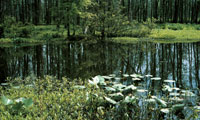
Did you know that a 3,660-acre wilderness area thrives only 26 miles from the heart of Times Square? And that it's the very first Fish & Wildlife Service-designated Wilderness Area in the country? There are eight miles to hike or watch birds in this wooded wetland at Great Swamp National Wildlife Refuge in Basking Ridge. Or just soak up the music of the woods croaks and warbles, the creak of limbs, the whisper of leaves and the shush of the wind. An untouched, non-mechanized, left-alone place to get back to nature; the middle of nowhere in the center of Jersey.
It was in the early 1960s that the Great Swamp Committee of the North American Wildlife Foundation recognized the beauty of the land, bought it, then donated it to the Department of the Interior. In '68, swampland was reclaimed, set aside and protected, and the Wilderness Area was created. "Man is a visitor," says Tom McFadden, outdoor recreation planner. "The goal is to allow natural processes to happen, and public recreation like hiking and a limited hunt."
The refuge has two areas: the managed and maintained, and the managed by non-management. Most public activity occurs in the Management Area, where a boardwalk passes through marsh, woods and swamp, and where a visitor could see a northern water snake catch a frog. There are observation blinds with scopes that overlook a great blue heron rookery, where the herons return in spring to build nests and raise their young. The scopes swivel 360 degrees so someone can watch the bluebirds along a field's edge. And there's even a 1.5-mile auto tour route so it's possible to see coyote, turkey and the occasional bear that passes through and hits the garbage, McFadden says, all without leaving your car.
In the Wilderness Area, you can hike all day and see no one except about 243 different species of birds. Try red-headed woodpeckers, barred owls, screech owls, red-bellied woodpeckers...you can hear them all too. In the fall, a walker can hear the talk of migrating snow geese and ducks...pintails, widgeons...in the impoundments created just for them. "Now as nature reclaims the area, some species like bluebirds have to move out." They moved to the fields in the Management side and McFadden says its one of the largest breeding populations of bluebirds in the state.
About 350,000 visitors a year come out to the management side. "The majority come just to look. I'm sure a lot of people come here for therapy. It's an easy place to come and get away. The strength of this refuge is its proximity to one of the largest populations of people and its accessibility to them," he says. "This is owned by every American. They should come here and enjoy it."
Great Swamp National Wildlife Refuge
152 Pleasant Plains Road, Basking Ridge, NJ 07920
973/425-1222
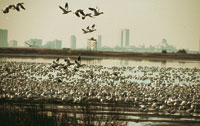

This oldest New Jersey refuge was two Brigantine and Barnegat that became one in 1984 and extends from Brick to Galloway Township on the Jersey Shore. Roughly 80 percent of the refuge's 46,000 acres is tidal saltwater marsh. "In summer, you run into a lot of mosquitoes, greenheads and deerflies," says Stephen Atzert, refuge manager. Of the remainder acreage, half is upland woods and half is freshwater swampland fed by streams.
The Brigantine Division of the refuge gets the most people traffic, with 200,000 cars a year on its 8-Mile Auto Tour Route on Wildlife Drive in Oceanville. Here, 600 acres of saltwater surround a 900-acre freshwater impoundment, built as mitigation for freshwater streams and marshes lost to nearby development. Visitors can observe freshwater ducks and shorebirds like semi-palmated plovers and sandpipers, and greater and lesser yellowlegs.
Spring draw-down in the impoundment allows migrating birds to feed on worms and bugs in the mud. The soil gets aerated and seeds of wetland plants, such as Walter's millet and spikerush, germinate. In summer, they let the water back in to keep the plants growing strong. "When the ducks come back in the fall, they have a table set with a feast for a king or queen," says Atzert. The best time of year for visitors is October and November when waterfowl pass through, he says. Snow geese, black ducks, mallards and green wing teal are easy to see from the drive. Except when birdwatching from the two observation points with "no-pay" spotting scopes, Atzert recommends that people stay in their cars. "Birds are much less disturbed by a car than by a person walking down the dike."
There are three walking trails at Brigantine. The half-mile Leeds Trail traverses salt marsh by boardwalk and woodland and is partially wheelchair accessible. A walker might see warblers on the quarter-mile Akers Woodland Trail, and Jen's Trail gives a glimpse of freshwater wetlands. The Barnegat Division offers visitors a chance to observe migratory birds by observation platform. The one-mile Willie deCamp Trail with benches on Montoloking Road in Brick Township rambles through upland woods and red maple swamp.
Under a Comprehensive Conservation Plan, the refuge plans to purchase 12,000 acres of upstream habitat watershed that so many wetlands depend on. If the land is kept green, water can infiltrate the soil instead of causing the flash floods of developed areas. Plus, neo-tropical migrants that fly here from South America in spring and summer are dependent on large tracts of forest. "If an area is less than 3,000 acres, they won't even breed," says Atzert. "It's important to keep as much forest area as we can around wetlands intact."
The refuge has been instrumental in increasing numbers of the threatened Atlantic coast piping plover, a little shorebird that nests on beaches. There are now 120 pairs of piping plovers on New Jersey's 127 miles of coastline the refuge has 30 pairs on six. "During nesting season, we close the beach down to everything but the birds." And for the last 15 years, there has been at least one nest of peregrine falcons at Brigantine.
They are busy at Edwin B. Forsythe, and they have been rewarded. They're one of the country's 19 "Wetlands of International Importance" sites, as designated by International Treaty of the Ramsar Convention. Their location on the Atlantic Flyway is important to migrating and wintering waterfowl. "Seventy percent of the Brant population winters in New Jersey and we probably have half of that." They're one of 40 units of the "Western Hemisphere Shorebird Reserve Network." Forsythe was chosen as a Jacques Cousteau National Estuarine Research Reserve for the study of intact ecosystems at Great Bay and lower Barnegat Bay.

The National Wildlife Refuge on the lower Delaware River is fighting in the name of its mission to preserve and enhance wildlife and their habitat. Almost 80 percent of the refuge is tidal marsh, ranging from brackish in the southern end to almost freshwater further north where wild rice grows. The refuge provides quality food habitat for waterfowl, herons, egrets and other long-legged wading birds (over 6,000 pairs) that nest on Pea Patch Island across the river in Delaware. Pea Patch is the largest heron rookery north of Florida.
One thousand acres of tidal marsh, reclaimed from the ditching and drying of farm days past, is now being claimed by a monoculture of the invasive Phragmites a useless, noxious weed almost impossible to eradicate. It forms a ten to fifteen-foot wall along streams so herons can't get in to feed, and has limited value as shelter or food. And it prevents the growth of native plant species that would support a wealth of animal life. The plant also creates a large amount of combustible material a problem at the wildlife/urban interface. Its good point is that redwing blackbirds roost in it at night.
The refuge has restored half of the 1,000 plus acres of Phragmites, some by excavation, an expensive and temporary measure. "Our management of Phragmites is controversial," says Tom Walker, refuge manager. "Some people think we should not introduce chemicals into the refuge, but it's the only way." Plans are to treat the weed with pesticide, then burn the carcasses that would act as mulch and prevent native wetland species from growing. They've tried everything else.
Beneficial insects are under scrutiny at Cornell University, but Walker says it takes years to get approval to make sure they don't become pests themselves. They could also deepen water levels to drown the weed, but species such as salt hay, wild rice, duck potato and arrow arum would also drown. Mowing works if done several times a year, "but the problem for wildlife is removing cover and disturbing nests of birds in grasslands," says Walker. "So much of the refuge is tidal marsh, it makes it a high priority."
Visitors can check out the restored 15.5 acres tidal marsh by trail on Lighthouse Road, and by car on Rt. 49 between Salem and Pennsville. The restored area is on the north side of 49, west of the Salem River.
Supawna Meadows NWR
197 Lighthouse Road, Pennsville, NJ 08070
856-935-1487
Cape May's National Wildlife Refuge is aflutter this fall with monarch butterflies, hawks and eagles (sometimes 50 to 100 at a time), huge flocks of warblers and swallows and other songbirds and shorebirds. The peninsula is a jumping off point from the Delaware Bay to the Virginia area as they fly south for the winter, including almost 80 percent of the red knots and ruddy turnstones that live in the western part of the globe. Other birds come from more northern areas to breed and spend the cold months on the beach at the Jersey shore.
"The migration is one of the biggest draws to the refuge," says Howard Schlegel, refuge manager. "It's one of the best breeding places on the East Coast. All the birds that use the Atlantic Flyway stop here."
In mid-September, the monarchs gather. Fields of milkweed are perfect habitat, and Schlegel says the trees can be covered in butterflies. "It's a spectacular thing."
The refuge has two main divisions: the Delaware Bay with 5,000 acres, and the Great Cedar Swamp with 5,000 acres associated with Cedar Creek Estuary in the southern part of the Pine Barrens. There are no trails in the undeveloped swamp, but canoeing, hunting and fishing are allowed. "Most who canoe Cedar Creek find places along the road and put in from there." Black ducks and common and hooded mergansers migrate to there for winter, but a small boat is needed to see them.
There are two hiking trails at the Delaware Bay Division, but Schlegel says the refuge is an urban-rural place. "We are pretty much in people's back yards. Often you won't know you're going through the refuge." We are within the little towns and communities." Perhaps the birds don't know it either given the refuge has the second largest concentration of shorebirds in the country.
He says most people visit Two Mile Beach, 500 acres of breeding ground acquired from the Coast Guard in 1998. Clearing it and providing this needed habitat is one of the refuge's biggest accomplishments, says Schlegel. The beach is closed from April 1 to October 1 so shorebirds, including piping plovers, semi-palmated plovers and sanderlings, can breed and concentrate on the beach to feed and fatten up before they head south. Controversy arose when people became unable to walk out to the jetties, so the refuge opened up a trail system that helps them do that. One trail winds behind the dunes so people can watch the shorebirds from an observation platform.
"One of the interesting things for me is there are thousands of people and no birds north of the boundary line, and south of the line there are thousands of birds and no people," he says. "It's kind of amazing."
Some of the refuges have special celebration activities for their centennial. Check them out this fall and enjoy some of the greatest birding in the country.
For more information on NJ's Wildlife Refuge Systems